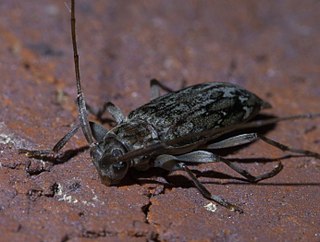
Lepturges is a genus of longhorn beetles of the subfamily Lamiinae. It was described by Henry Walter Bates in 1863.

Lepturges angulatus is a species of longhorn beetle of the subfamily Lamiinae. It was described by Humphrey Critchley-Salmonson in 1852.

Lepturges symmetricus is a species of longhorn beetle of the subfamily Lamiinae. It was described by Samuel Stehman Haldeman in 1847.

Lepturges confluens is a species of longhorn beetle of the subfamily Lamiinae. It was described by Samuel Stehman Haldeman in 1847.
Lepturges infilatus is a species of longhorn beetles of the subfamily Lamiinae. It was described by Henry Walter Bates in 1872.
Lepturges megalops is a species of longhorn beetle of the subfamily Lamiinae. It was described by Hamilton in 1896. It is a widespread neotropical species that can be found in Florida, the Bahamas, Guatemala, Honduras, and Panama.

Lepturges pictus is a species of longhorn beetle of the subfamily Lamiinae. It was described by John Lawrence LeConte in 1852.

Lepturges regularis is a species of longhorn beetle of the subfamily Lamiinae. It was described by John Lawrence LeConte in 1852.

Lepturges vogti is a species of longhorn beetles of the subfamily Lamiinae. It was described by Hovore and Tyson in 1983.
Lepturges abditus is a species of beetle in the family Cerambycidae. It was described by Monné in 1976.
Lepturges citrinus is a species of beetle in the family Cerambycidae. It was described by Monné in 1976.
Lepturges anceps is a species of beetle in the family Cerambycidae. It was described by Gilmour in 1962.
Lepturges angustatus is a species of beetle in the family Cerambycidae. It was described by Bates in 1863.
Lepturges dorsalis is a species of beetle in the family Cerambycidae. It was described by White in 1855.
Lepturges festivus is a species of beetle in the family Cerambycidae. It was described by Bates in 1872.
Lepturges hahneli is a species of beetle in the family Cerambycidae. It was described by Gilmour in 1959.
Lepturges insignis is a species of beetle in the family Cerambycidae. It was described by Melzer in 1928.
Lepturges laetus is a species of beetle in the family Cerambycidae. It was described by Melzer in 1928.

Lepturges macilentus is a species of beetle in the family Cerambycidae. It was described by Bates in 1881.
Lepturges scriptus is a species of beetle in the family Cerambycidae. It was described by Gilmour in 1958.






